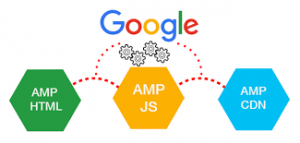What are Accelerated Mobile Pages?
The mobile-first mindset isn’t going anywhere as of now. The statement holds true from both the business and consumer side. It may quite interest you to know that there are around 30 billion mobile moments when a customer consults their phone and expects an immediate action in return. This inevitably means every day you as a business or as a brand has 30 billion mobile opportunities to offer something interesting to the end users. Of course, there is a strong reason behind it- users get instant gratification. Now tell me something how long do you wait for a mobile webpage to load? According to Google and SOASTA 40% of consumers leave a page that takes longer than three seconds to load.

The Accelerated Mobile Pages (AMP) Project is a new initiative backed by Google, Twitter and over 30 million or even more web publishers focusing on delivering more bare bone experiences especially in regards to web content as fast as possible. Content, as well as the speed, are the two primary criteria’s of these pages. Many of you have this misconception AMP, and responsive websites are the same, but in the actual scenario, they are not! Responsive websites take your existing website code and adjust the content of your page to render properly for a specific device size whereas AMP is actually unique website code that strips out all extraneous code that increases load times – and only renders the most needed code on mobile devices. Now let me get you acquainted with the actual scenario, if an online shopping site is making $100,000 per day, a 1-second page delay could potentially cost you $2.5 million in lost sales every year. Are you ready to bear such losses? Didn’t think so?

So all you have is “Three Seconds” where you can grab the attention of users who liked your ad or clicked it for more information. In case, during such critical situation if your webpage fails to load everything gets wasted irrespective of how compelling your work was, everything in vain. Mobile sites take around 6.9 seconds to load, that’s more than double the amount of time 40% of users wait before abandoning the page. Anytime Google rolls out a new update; people think they are concerned with generating more money. Which is ultimately true, the happier its users are, the more they come back to Google, and that means more advertisers.
Faster mobile pages + readable content = better user experience

Its components include:
- HTML- JavaScript is not at all permitted, a different markup of traditional HTML code along with a unique tag is used. The AMP framework requires you to use a streamlined version of CSS.
- JS- Mainly used to fetch resources and stripped down to eliminate unimportant rendering, the AMP’s vast JS component library, can enable you to load content, create animation, modifies the layout, and much more.
- CDN- The proxy-based content delivery network (CDN), commonly known as AMP Cache, is a critical component of the AMP platform. It retrieves the AMP content and caches it for fast delivery.

How does Google Accelerated Mobile Pages load a page faster?
- Execute all the AMP Javascript asynchronously that is AMP creates individual JavaScript for all the blocks of the content, and load separately. So, for one particular section, the entire page doesn’t have to endure in rendering.
- The load size and structure of AMP doesn’t require any assistance from resources. The browser is unaware of how long does the structure of the page is going to be; however, in the case of Google AMP, it determines the size of the ads, content, or visuals.
- Keep all the third-party Javascript in sandbox iframe, and Google AMP ensures that the third-party JavaScripts can’t block the rendering of the main page elements. Simply put, third-party ads won’t damage the load speed of the main webpage content.
- AMP can prioritize resource loading which allows the webpage to load essential elements like content, images, etc. faster.
Where is AMP effective?
- Homepage- Homepage is one of the best pages to start-off. If you can load the homepage fast, nothing can stop you from gaining plenty of customers.
- Product category pages- The next vital page to take into account is the product category page where AMP needs to be added. So, when a user Googles the product, the AMP powered pages have increased chances of ranking as they are relatively fast.
- Product pages- With Amp, all the loading elements on the product pages can be prioritized. Right from images to product descriptions; AMP has the potential to recognize such elements and deliver the third party JS loaded later.
Author Bio:
Charles Richards working as a Business Analyst at Tatvasoft UK a leading mobile app development company in UK. Besides of his profession Richards likes to share some new and trending technical aspects.


Comments
0 comments